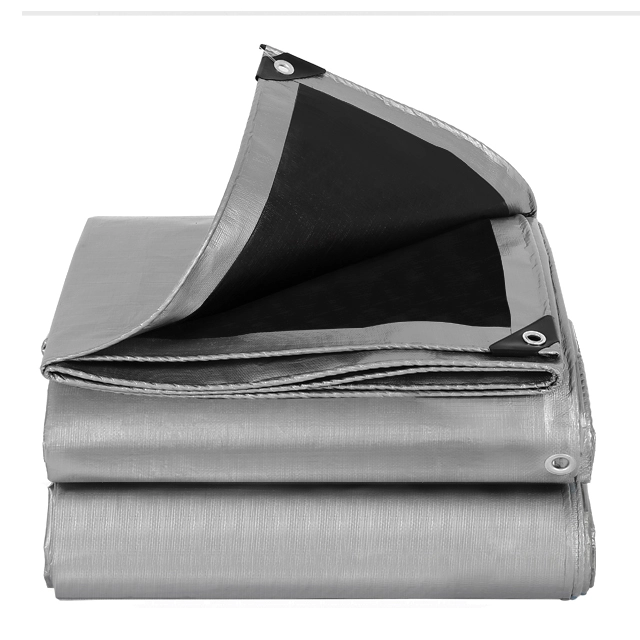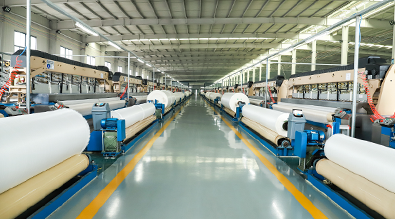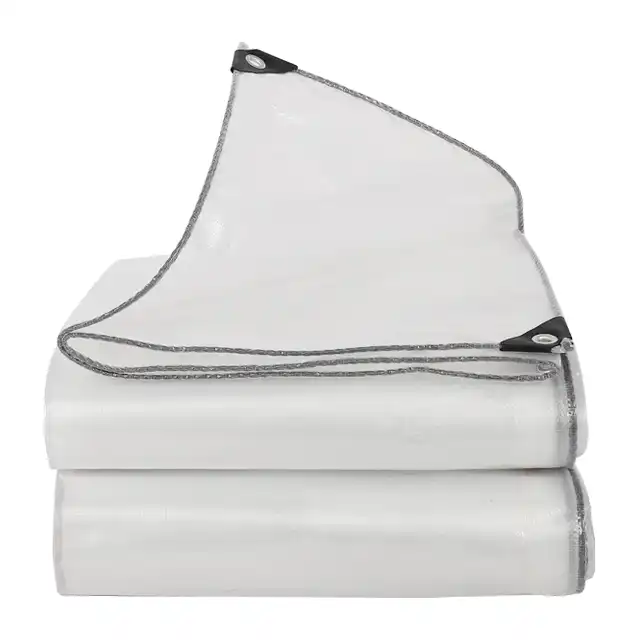How to Protect Construction Materials with PE Tarps?
Construction materials represent significant investments that require proper protection from environmental elements, moisture, UV radiation, and various site hazards. PE tarpaulins offer excellent water resistance and UV protection, making them essential for protecting construction materials from rain, moisture, and sun damage. The polyethylene construction tarpaulin serves as a versatile, cost-effective solution that shields valuable materials including lumber, steel, concrete, and equipment from weather-related deterioration. These protective covers not only preserve material integrity but also reduce project costs by preventing waste and extending material lifespan. With proper installation and selection, construction tarpaulin becomes an indispensable tool for maintaining site organization and protecting investments throughout the construction process.
Essential Features and Benefits of PE Construction Tarps

Superior Weather Protection Capabilities
Professional construction tarpaulin manufactured from high-quality polyethylene provides exceptional protection against multiple environmental threats. The PE tarpaulin is inherently water-resistant, with polyethylene fibers that do not absorb water, creating an impenetrable barrier against rain and moisture. This fundamental characteristic ensures that construction materials remain dry even during extended periods of inclement weather, preventing costly damage from water infiltration, rust formation, and material degradation. The advanced waterproofing technology employed in premium construction tarpaulin includes multi-layer lamination processes that enhance durability and longevity. High-grade materials feature LDPE laminated surfaces on both sides, creating a seamless protective barrier that prevents water penetration while maintaining flexibility in various temperature conditions. The heat-sealing technology utilized in manufacturing ensures that all seams remain watertight, eliminating potential weak points that could compromise material protection. Temperature resistance represents another critical advantage of quality PE construction tarpaulin. These materials maintain their protective properties across wide temperature ranges, from extreme cold conditions where flexibility prevents cracking to high-temperature environments where UV stabilizers prevent degradation. The molecular structure of polyethylene provides inherent resistance to thermal cycling, ensuring consistent performance regardless of seasonal weather variations.
Advanced UV Resistance and Longevity
PE tarpaulins are treated with UV-resistant coatings, which protect them from solar degradation and ensure longer useful life even when exposed to prolonged sunlight. This UV protection technology is crucial for construction sites where materials require extended outdoor storage. The specialized additives incorporated during manufacturing process create a protective barrier that reflects harmful ultraviolet radiation, preventing polymer chain breakdown that leads to brittleness and failure. The construction tarpaulin UV resistance extends beyond mere surface protection to include stabilization of the underlying polyethylene matrix. Advanced formulations include multiple UV inhibitor systems that work synergistically to absorb, reflect, and neutralize different wavelengths of ultraviolet radiation. This comprehensive approach ensures that the tarpaulin maintains its structural integrity, color stability, and protective capabilities throughout extended exposure periods. Long-term performance data demonstrates that premium PE construction tarpaulin can maintain effective protection for multiple years when properly maintained. The combination of UV stabilizers, anti-oxidants, and thermal stabilizers creates a material system that resists degradation from multiple environmental stressors simultaneously. This longevity translates into reduced replacement costs and consistent material protection throughout extended construction projects.
Versatile Application Methods and Installation Techniques
Construction tarps prove invaluable for protecting building interiors from elements, preventing moisture accumulation on scaffolding, covering equipment, and creating temporary walls or fences. The versatility of construction tarpaulin applications extends from ground-level material storage to elevated scaffold enclosures, providing comprehensive site protection solutions. Professional installation techniques maximize the protective effectiveness of construction tarpaulin systems. Proper tensioning prevents water pooling and wind-driven moisture infiltration while ensuring adequate ventilation to prevent condensation formation. The integration of reinforced grommets and edge treatments allows for secure anchoring using various fastening systems including rope, bungee cords, and mechanical fasteners. Strategic placement considerations include slope orientation for water runoff, overlap specifications for seam integrity, and anchoring point distribution for wind load resistance. The construction tarpaulin installation process requires attention to potential puncture sources, sharp edges, and high-wear areas where additional reinforcement may be necessary. Proper installation practices ensure maximum material protection while extending tarpaulin service life.
Strategic Material Protection Methods
Lumber and Wood Product Preservation
Wood materials represent one of the most vulnerable construction components requiring comprehensive protection from moisture, UV exposure, and ground contact contamination. Construction tarpaulin provides essential barriers that preserve wood dimensional stability, prevent fungal growth, and maintain structural integrity. Proper coverage techniques include elevated storage systems that promote air circulation while providing complete weather protection. The moisture management capabilities of PE construction tarpaulin prevent the rapid moisture cycling that causes wood warping, splitting, and checking. By maintaining consistent moisture content levels, protected lumber retains its engineered properties and dimensional stability throughout storage periods. The breathable characteristics of properly ventilated tarp systems allow moisture equalization without exposing materials to direct precipitation or ground moisture. Specialized lumber protection configurations utilize construction tarpaulin in multi-layer systems that provide both ground barriers and overhead coverage. The ground protection layer prevents moisture wicking from soil contact while the overhead covering shields materials from precipitation and UV exposure. This comprehensive approach ensures that lumber maintains grade specifications and structural properties throughout extended storage periods.
Metal and Steel Component Protection
Metal construction materials require protection from corrosion-inducing moisture, chloride contamination, and galvanic reactions that compromise structural integrity. Construction tarpaulin systems designed for metal protection incorporate vapor barrier properties that prevent condensation formation while allowing controlled ventilation to prevent humidity buildup. The chemical resistance properties of quality PE construction tarpaulin provide protection against industrial atmospheric contaminants that accelerate metal corrosion processes. These materials resist degradation from exposure to salt spray, industrial emissions, and chemical vapors commonly present in construction environments. The inert nature of polyethylene prevents chemical reactions that could transfer contaminants to protected metal surfaces. Advanced metal protection strategies utilize construction tarpaulin in combination with desiccant systems and ventilation controls to create optimal storage environments. The implementation of proper drainage systems prevents water accumulation that leads to accelerated corrosion while maintaining protective coverage integrity. Proper metal protection extends material service life and preserves structural specifications throughout project duration.
Concrete and Masonry Material Safeguarding
Concrete and masonry materials require protection from premature drying, freeze-thaw cycling, and contamination that affects curing processes and final strength characteristics. Construction tarpaulin provides essential moisture control and temperature moderation that ensures proper hydration and strength development in concrete applications. The thermal insulation properties of construction tarpaulin help moderate temperature fluctuations that can cause thermal stress cracking in concrete and masonry materials. By reducing rapid temperature changes, tarp coverage promotes uniform curing processes and prevents differential expansion that leads to structural defects. The wind protection provided by properly installed tarpaulin systems prevents excessive moisture loss during critical curing periods. Specialized concrete protection applications utilize construction tarpaulin in curing blanket configurations that maintain optimal moisture and temperature conditions for strength development. These systems incorporate controlled ventilation and moisture retention capabilities that extend working time while ensuring proper hydration. The protection provided during vulnerable curing periods significantly impacts final concrete strength and durability characteristics.
Quality Standards and Manufacturing Excellence
Advanced Production Technologies
Modern construction tarpaulin manufacturing incorporates sophisticated production technologies that ensure consistent quality and performance characteristics. The yarn extrusion process utilizes high-tech machinery capable of producing fibers ranging from 400D to 2500D, providing flexibility in material specifications for diverse application requirements. Advanced water-jet loom systems, including specialized wide-width configurations up to 5 meters, enable seamless fabric production without joints that could compromise structural integrity. The fabric coating process represents a critical manufacturing stage where professional technicians utilize large-scale coating machines to apply protective layers with precise thickness control. This process ensures uniform coverage and optimal adhesion between the polyethylene base material and protective coatings. The integration of heat-sealing technology eliminates potential failure points by creating molecularly bonded seams that match or exceed base material strength characteristics. Quality control systems implemented throughout the manufacturing process include real-time monitoring of material properties, dimensional specifications, and performance characteristics. Advanced testing equipment validates tear resistance, puncture strength, UV stability, and water resistance properties to ensure consistent product performance. The implementation of ISO 9001:2015 certification standards demonstrates commitment to quality management and continuous improvement processes.
Customization and Technical Specifications
Professional construction tarpaulin manufacturers offer extensive customization capabilities to meet specific project requirements and environmental conditions. Custom width specifications ranging from 1.5 to 5 meters without seams provide optimal coverage for various material protection applications. The availability of different mesh configurations from 6×6 to 16×16 allows selection of optimal strength-to-weight ratios for specific applications. Denier specifications ranging from 600D to 1800D provide flexibility in selecting appropriate material strength for different protection requirements. The GSM (grams per square meter) range from 75 to 400 enables precise specification of material thickness and durability characteristics. Custom printing capabilities allow for identification, branding, and safety marking integration directly into the tarpaulin material. Advanced edge treatments including stereo edging with reinforcing rope, heat-folded seams, and metal grommets enhance installation convenience and long-term durability. Plastic corner reinforcements provide additional protection at high-stress points while maintaining material flexibility. These manufacturing enhancements ensure reliable performance throughout extended service periods under challenging construction site conditions.
International Standards and Certifications
Quality construction tarpaulin manufacturers maintain partnerships with international organizations including UNHCR, IOM, ICRC, and UNICEF, demonstrating capability to meet rigorous performance and quality standards. These partnerships require compliance with strict material specifications, performance criteria, and manufacturing quality standards that exceed typical commercial requirements. Export capabilities spanning over 30 countries including demanding markets in North America, Europe, and developing regions demonstrate consistent quality maintenance across diverse climatic conditions and application requirements. The ability to meet varied international standards and regulatory requirements indicates sophisticated quality management and technical capability. Third-party testing laboratory results provide independent verification of material performance characteristics including tear strength, puncture resistance, water resistance, and UV stability. These testing protocols follow international standards and provide objective performance data that supports material selection and application decisions. The accumulated reputation in international markets over 15+ years provides evidence of consistent quality delivery and customer satisfaction.
Conclusion
Effective construction material protection using PE tarps requires understanding of material properties, proper installation techniques, and quality product selection. The combination of water resistance, UV protection, and durability makes construction tarpaulin an essential component of successful project management. Professional-grade materials from established manufacturers ensure reliable performance and long-term cost effectiveness.
Looking for reliable China Construction Tarpaulin factory solutions? As a leading China Construction Tarpaulin supplier and China Construction Tarpaulin manufacturer, we offer comprehensive China Construction Tarpaulin wholesale options with competitive Construction Tarpaulin price structures. Our High Quality Construction Tarpaulin products and Construction Tarpaulin for sale options meet international standards while providing exceptional value. Contact us at info@shengdetarp.com to discuss your construction material protection requirements and discover how our expertise can benefit your projects.
References
1. "Polyethylene Tarpaulins: Properties and Applications in Construction" - Anderson, M.R. and Thompson, K.L., Journal of Construction Materials, 2023
2. "Weather Protection Systems for Construction Materials" - Chen, W., Rodriguez, P., and Kumar, S., International Construction Technology Review, 2024
3. "UV Degradation and Stabilization of Polyethylene Materials" - Williams, D.J. and Brown, A.M., Polymer Protection Technology, 2023
4. "Moisture Management in Construction Material Storage" - Johnson, R.T., Park, H.S., and Miller, L.A., Construction Engineering Quarterly, 2024




